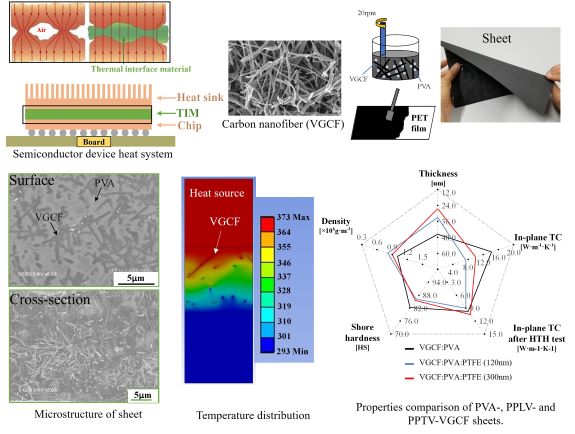Key points of this research results
- We have successfully developed a thermal interface sheet with thermal conductivity in the range of 7-14 W/m·K using randomly oriented carbon nanofibers. We obtained results superior to those of 1 to 4 W/m·K of grease-based TIM, which is widely used today.
- We have developed a process that can fabricate a thermal interface material sheet with controlled thickness by mixing carbon nanofibers in PVA.
- By mixing PTFE with PVA, we obtained the result that the thermal properties do not deteriorate under high temperature and high humidity conditions.
Outline
Thermal interface materials are attracting attention as they efficiently dissipate the heat generated inside electronic devices (CPU, LED backlight, power chip) to the outside. A thermal interface material is a material that is sandwiched between the heat-generating part and the heat-dissipating part to prevent a gap due to unevenness. Although there are various types of thermal interface materials, there is a demand for the development of thermal interface sheets as thermal interface materials that are superior in terms of workability, cost, and usage conditions.
The thickness of the developed carbon nanofiber thermal interface sheet is between 25 µm and 50 µm, and a dense sheet with few pores could be fabricated. As a result of observing the structure of the carbon nanofiber thermal interface sheet, PVA and PPTE infiltrate between the carbon nanofibers and the carbon nanofibers are randomly oriented. The average hardness (Hs) of the carbon nanofiber thermal interface sheet is about 84, which makes it difficult to break even when bent, and has excellent workability due to its smooth touch. By comparing the thermal conductivity and thermal resistance of grease, which is a thermal interface material currently used in many situations, it can be positioned as a high-performance thermal interface sheet with excellent thermal resistance and thermal conductivity.

Reference
published in Scientific reports (IF=4.997), Article number: 17183 (2021) DOI: 10.1038/s41598-021-96691-z

 Home
Home



